When it comes to storing a kayak, finding the right solution can be a bit tricky, especially when space is limited. Luckily, I’ve got you covered on how to hang a kayak in a garage easily and efficiently, freeing up valuable floor space and ensuring your prized possession remains in optimum condition.
There are many ways to store a kayak in a garage, but hanging it is one of the most popular and secure options. Before diving in, it’s important to first consider factors like your kayak’s weight, available space, and the type of hanging or hoisting system that will work best in your situation.
Once you’ve assessed your needs, you’ll be ready to confidently hang your kayak in your garage, making it accessible for your next paddling adventure while preserving its lifespan. Stay tuned as I share tips and steps on hanging a kayak, as well as useful suggestions on selecting the appropriate hardware and storage solutions.
Contents
Contents
Why Proper Kayak Storage Matters?
When it comes to kayaking, one aspect that’s often overlooked is how to properly store your kayak. So, why does proper kayak storage matter? I’ll delve into the reasons while focusing on the garage as a storage space.

A key reason to prioritize appropriate storage is to preserve the integrity and lifespan of your kayak. Storing a kayak outdoors or without any support can cause hull deformation, scratches, and fading due to UV exposure. A garage offers shelter from the elements and helps protect your investment for years to come.
Another benefit of storing your kayak in the garage is the reduction of theft risk. A kayak left outside can be an easy target for thieves. Keeping it inside your garage ensures it’s in a secure location, significantly decreasing theft opportunities.
Proper storage also includes correct positioning, which is why hanging your kayak in the garage is an ideal method. Suspending it horizontally with quality straps or a specifically designed kayak hoist can prevent uneven pressure on the hull, reducing the risk of damage.
Now let’s talk about the organization and space management benefits. A kayak can take up a significant amount of space, so hanging it in your garage allows you to use the vertical space more efficiently. This method facilitates a clutter-free environment, with room for other essential outdoor gear.
To summarize, here are the main benefits of proper kayak storage in a garage:
- Preserving the integrity and lifespan of your kayak
- Reducing theft risk
- Preventing hull deformation
- Efficiently using garage space
It’s clear that understanding how to hang a kayak in a garage is valuable for any kayak owner. Proper storage is essential to protect and prolong the life of your equipment while also effectively managing your garage space. So, let’s dive into some practical tips and recommendations on how to set up the perfect storage system in your garage.
Choosing The Right Storage Solution
When it comes to figuring out how to hang a kayak in a garage, it’s important to choose the right storage solution. There are various systems available that can help maximize space and keep your garage organized. In this section, we’ll explore a few different storage solutions and factors to consider when choosing one for your garage.
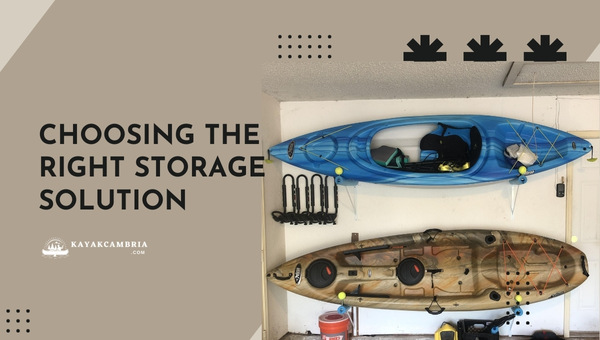
First, let’s take a look at some of the most popular kayak storage systems:
- Wall-mounted racks: These systems typically consist of a pair of brackets that hold the kayak horizontally against a wall. Wall-mounted racks are great for freeing up floor space and can be installed at any height to accommodate various kayak sizes.
- Ceiling-mounted hoists: As the name suggests, this type of system uses ropes or straps attached to pulleys to lift and suspend the kayak from the ceiling. Ceiling-mounted hoists are ideal for garages with high ceilings and limited wall space.
- Freestanding racks: If you’re not a fan of attaching systems to your walls or ceilings, freestanding racks might be the perfect solution. These racks come in various styles, such as upright or pole-mounted, and can store multiple kayaks.
Consider the following factors when choosing a storage system for your kayak:
- Space availability: Take into account the size of your garage and the amount of available wall, floor, or ceiling space before choosing a storage system. Make sure there’s enough room to maneuver and store your kayak securely.
- Weight capacity: Ensure the storage solution you choose can handle the weight of your kayak. Most systems will list the maximum weight capacity, so be sure to check before purchasing.
- Ease of use: Some systems may be more challenging to install and use than others. If you plan on using your kayak frequently, it’s essential to find a solution that makes it easy to access and store the kayak without too much hassle.
- Budget: Prices can vary significantly among different storage systems. Set a budget for your kayak storage solution and research your options within that price range.
By evaluating these factors, you’ll be better equipped to choose the perfect kayak storage solution for your garage. Once you’ve identified the right system, you can look forward to enjoying the convenience and organization that a well-planned garage storage solution offers.
How To Hang A Kayak In A Garage: Step-by-Step Guide
Knowing how to hang a kayak in a garage is essential for kayak enthusiasts. It ensures efficient use of storage space and protects your valuable equipment. I’ll walk you through the process with this easy-to-follow guide. Before diving into the installation steps, it’s important to keep in mind some general pointers for properly storing your kayak:
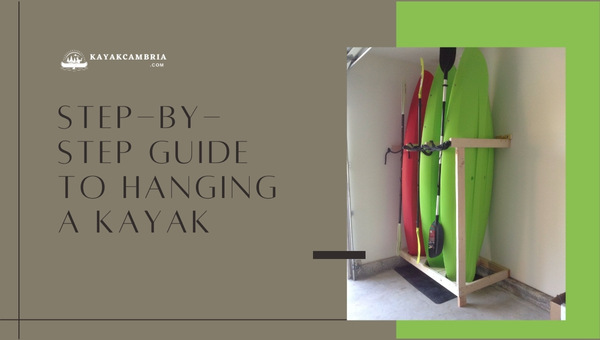
- Always store your kayak in a cool, dry place, away from direct sunlight.
- Be mindful of weight distribution to prevent damage to your kayak over time.
- Use padding or straps to hold the kayak securely and protect it from scratches.
With the essentials covered, here’s a step-by-step explanation to hang a kayak in your garage:
1. Select a storage method
You have several options when it comes to hanging a kayak:
- Wall-mounted racks
- Ceiling hoists
- Freestanding racks
- Suspended straps Each has its pros and cons, so consider your garage space, budget, and need for accessibility when choosing the right method.
2. Determine the ideal location
Look for a space in your garage with sufficient clearance for your kayak’s length and width. Depending on your chosen storage method, make sure the location can support the weight of the kayak, and it’s easily accessible for loading and unloading.
3. Gather necessary tools and materials
Ensure you have the proper tools and equipment for installation, such as:
- Drill and drill bits
- Stud finder
- Level
- Wrench or socket set
- Kayak storage system (selected in step 1)
- Tape measure
- Protective goggles
4. Begin installation
Following the specific instructions provided with your selected storage system, perform the steps below:
- Wall-mounted racks: Locate and mark the studs in the wall, then drill holes for mounting brackets. Secure the brackets with the appropriate hardware and attach the rack. Test the rack by pulling on it; it should feel sturdy.
- Ceiling hoists: Find and mark the ceiling joists, then install pulleys and mounting brackets according to the product’s instructions. Secure the hoist straps or ropes around your kayak and test the stability of the system by raising and lowering the kayak.
- Freestanding racks: Assemble the rack according to the manufacturer’s instructions, and position it in the desired location. Load your kayak onto the rack’s arms, ensuring proper support and balance.
- Suspended straps: Find and mark the ceiling or wall studs. Hang straps or ropes from the secured points in a wide enough position to accommodate your kayak’s width. Place your kayak in the straps, double-checking for even weight distribution and secure support.
As you follow the guide, exercise caution and double-check your measurements to ensure a stable, secure hanging solution for your kayak. With proper installation, you’ll efficiently use your garage space and keep your kayak in great condition.
Hang A Kayak In A Garage Using A Hoist System
When it comes to how to hang a kayak in a garage, a popular and effective solution is using a hoist system. It’s important to understand the benefits of this method, as well as how to properly install and use one. I’ll provide a step-by-step guide on using a hoist system, including crucial safety tips.
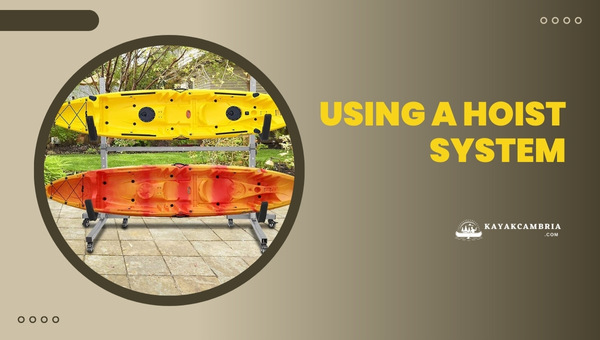
A hoist system offers several advantages:
- Space-saving: Since the kayak is lifted off the floor and overhead, it frees up valuable floor space in your garage.
- Easy access: Retrieving the kayak from the ceiling is quick and hassle-free.
- Security: Properly installed hoists are secure and prevent potential accidents, keeping your kayak safe from damage or theft.
Here’s a quick rundown on how to install and use a hoist system for your kayak:
- Select the right hoist system: First and foremost, you need to find the right hoist system for your needs. Consider the kayak’s weight and adjustability requirements. A quality hoist system will be sturdy, reliable, and equipped with safety features such as locking mechanisms.
- Determine the location: Next, plan where you want to hang your kayak. Ensure that the location provides enough clearance for your kayak, as well as easy access when you need to retrieve it.
- Install the hoist system: Follow the manufacturer’s instructions to securely install the hoist system to the ceiling or overhead beams. This process typically involves attaching mounting brackets, running rope or cables through pulleys, and attaching the kayak straps or hooks.
- Lift and secure the kayak: Carefully place your kayak onto the straps or hooks, adjusting to evenly distribute the weight. Gradually hoist the kayak upward, making sure it is level and secure. Finally, engage any safety locking mechanisms to prevent accidental release.
Here are some safety tips to keep in mind when using a hoist system:
- Check the weight capacity of the hoist system before lifting your kayak.
- Inspect the hoist periodically for any signs of wear or damage, and replace any worn or damaged parts.
- Do not let children operate the hoist without adult supervision.
Using a hoist system to hang a kayak in a garage is a practical, efficient, and safe solution that maximizes garage space and provides easy access. Remember to choose the right system, find the ideal location, and follow all safety protocols to ensure the security and longevity of your kayak.
Hang A Kayak In A Garage Utilizing Wall-Mounted Racks
Hanging a kayak in your garage can be a fantastic way to store it safely and securely, saving you plenty of floor space in the process. One of the most popular and efficient storage methods is using wall-mounted racks. In this section, I’ll be discussing how to utilize wall-mounted racks effectively, to ensure your kayak is stored the right way.
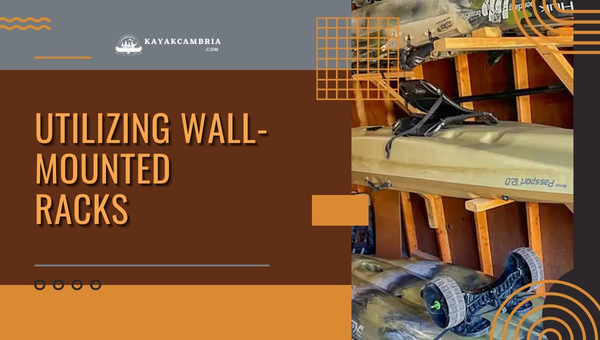
First, let’s explore the different types of wall-mounted racks available. Several options you can consider include:
- Padded brackets: These brackets, usually made of steel or other durable material, are lined with padding to protect your kayak from scratches and wear. They’re an excellent choice for those seeking a reliable and affordable solution.
- Kayak cradles: These cradles are designed specifically for kayaks, holding them in place by their shape. They can either be horizontal or vertical, depending on your storage preference and available space.
- Slings: Made of durable straps or cords, these slings allow you to suspend your kayak from the garage wall. They can be adjusted to fit various kayak sizes.
When selecting the perfect wall-mounted rack for your garage, keep in mind these factors:
- Available space: Make sure that the wall-mounted storage solution you choose is compatible with the dimensions of your garage — don’t forget the height or width of your kayak when considering this aspect.
- Weight capacity: Check the maximum weight capacity of the rack to ensure it can handle your kayak’s weight.
- Ease of installation: Some racks are easier to install than others, but always ensure you have the necessary tools and understand the mounting process to prevent any mishaps or accidents.
Once you’ve chosen a suitable wall-mounted rack, follow these steps to install the rack and hang your kayak:
- Measure your kayak’s dimensions — length, width, and height — to determine the proper positioning for the rack.
- Locate the wall studs in your garage using a stud finder. Mounting the rack on studs ensures a secure and stable hold for your kayak.
- Mark the stud locations with a pencil and drill pilot holes.
- Secure the brackets, cradles, or slings to the wall studs with screws or bolts, per the manufacturer’s instructions.
- Ensure that the rack is level and firmly attached to the wall.
- Carefully lift your kayak and place it onto the wall-mounted rack, making sure it’s properly supported and secure.
Now that you know how to hang a kayak in a garage using wall-mounted racks, feel free to explore other storage methods and find the one that suits you best. Remember, the key to successful kayak storage is the ease of access, protection, and efficient use of available space!
Hang A Kayak In A Garage By Installing Padded Hooks
When it comes to how to hang a kayak in a garage, installing padded hooks is a handy and efficient solution. I’ve found padded hooks to be not only space-saving but also protective of my kayak’s surface. In this section, I’ll guide you through the process of installing padded hooks to help you store your kayak safely and securely.
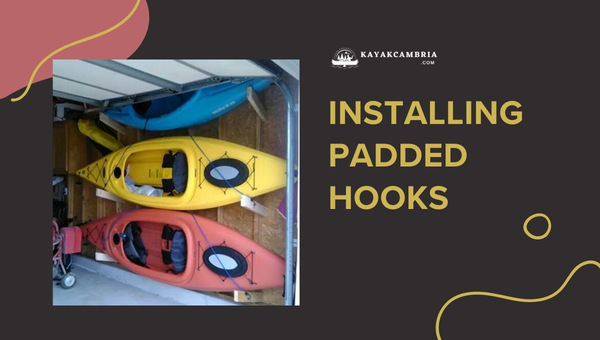
First, you’ll want to measure and mark the spots where you’ll install the hooks. Ensure that the width between the hooks corresponds with the width of your kayak. It’s crucial to pick a location that provides enough clearance for your kayak, so be mindful of the kayak’s length when selecting your spot. Also, be sure to avoid places near power outlets or other potentially hazardous areas in your garage.
The next step is to gather your tools. Here’s a list of items you’ll need:
- Padded hooks (also known as kayak wall mounts or J-hooks)
- Stud finder
- Drill
- Level
- Pencil
- Measuring tape
- Safety goggles
Once you have all your tools ready, it’s time to find the studs in your garage wall. You’ll want to secure your hooks to the studs to ensure they can support the weight of your kayak. Using your stud finder, locate the studs and mark their locations with a pencil.
Next, it’s important to level and mark the locations for your hooks. Place your level on the wall at your desired height, making sure it’s parallel to the ground. When it’s level, mark the locations for each hook, making sure to align them with the studs you found earlier.
Now you’re ready to install the hooks. With your drill, create pilot holes at the marked locations. This will make it easier to install the hooks and minimize the risk of splitting the wood. Once the pilot holes are drilled, insert the hooks and tighten them securely. It’s a good idea to double-check their stability by giving them a gentle tug.
Finally, it’s time to hang your kayak. Lift the kayak and place it into the padded hooks, resting the kayak on the hooks’ padded surfaces. Make sure the weight of the kayak is evenly distributed and secure before letting go.
With your padded hooks installed, you’ve now mastered how to hang a kayak in a garage. This practical storage solution will help keep your garage organized and protect your kayak from potential damage.
Hang A Kayak In A Garage Using Straps
When figuring out how to hang a kayak in a garage, one key aspect is securing the kayak with straps. It’s essential to choose the right straps and anchor points to ensure your kayak stays safe and damage-free while hanging in the garage. In this section, I’ll guide you through the process of securing your kayak with straps.
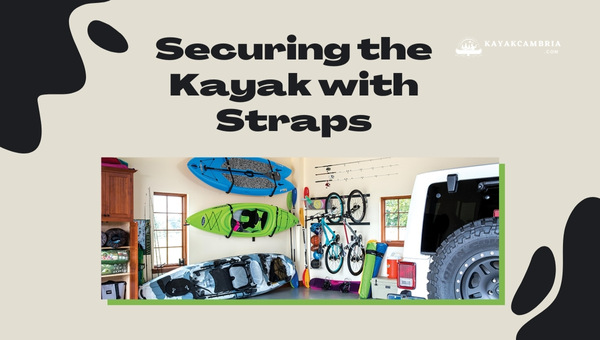
Firstly, you’ll need to select the best straps for your kayak. There are several types available on the market:
- Cam straps: These are easy to use and secure, with adjustable straps and a buckle for tightened tension.
- Ratchet straps: More heavy-duty than cam straps, these provide extra security and tightness but can be a bit more complicated to use.
- Padded straps: Designed with additional padding, these straps provide extra protection for your kayak.
Once you’ve chosen your straps, it’s time to find the proper anchor points in your garage. Ideally, you should aim for wall studs or ceiling joists, as they can support the kayak’s weight. Here’s how to locate and secure these anchor points:
- Using a stud finder, locate studs or joists in your desired hanging location.
- Mark the positions with a pencil.
- Decide on the appropriate distance for the two anchor points – this will depend on the size of your kayak.
- Install secure eye bolts, hooks, or paddle hangers into the marked positions, ensuring they can handle the kayak’s weight.
Now that you have secured your anchor points, follow these steps to hang your kayak using the straps:
- Position your kayak below the anchor points, either horizontally or vertically depending on your preference and available space.
- Place one strap around the kayak, ensuring it’s properly positioned to support the kayak’s weight. If you’re using padded straps, ensure the padded section is in contact with the kayak.
- Secure the strap to the first anchor point, adjusting the strap length as required.
- Attach a second strap to the kayak, repeating step 2, and secure it to the second anchor point.
- Check to make sure the straps are evenly distributing the kayak’s weight and aren’t causing any damage to the hull.
- Adjust the straps if needed to ensure a snug and secure fit.
Storing Accessories And Gear
While learning how to hang a kayak in a garage, it’s essential not to overlook the importance of properly storing your accessories and gear. The kayak is just one part of the equation; you’ll also need to ensure that paddles, life jackets, helmets, and other essential items are stored correctly to prolong their lifespan and maintain their effectiveness.
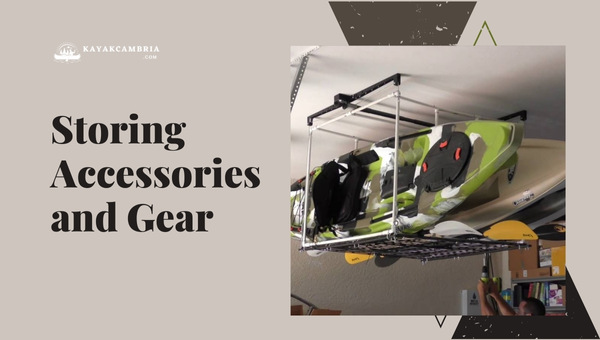
One effective way to store these items is to use hanging racks, hooks, or pegs along your garage walls. This approach optimizes your storage space and makes your gear easily accessible. Here are some tips for making the most of these storage options:
- Paddles: Try using hooks or brackets to hang your paddles horizontally. This setup will keep them out of the way and help prevent any potential damage.
- Life Jackets: Hang life jackets on sturdy hooks, ensuring they’re not crumpled or folded. This method will help with drying, minimizing the risk of mold or mildew.
- Helmets: Place helmets on simple wall hooks or pegs. Ensure that they’re hung securely and spaced appropriately to avoid potential damage.
You can also consider using storage bins or shelves. Labeling these storage units will save time when searching for specific gear. Bins work particularly well for smaller, miscellaneous items such as:
- Safety whistles
- Personal flotation devices (PFDs)
- Repair kits
- Kayak anchors
- Waterproof bags
Another important aspect of storing your accessories and gear is regular maintenance. Ensure that all items are clean, dry, and in good working condition before putting them away. Here’s a quick checklist to follow:
- Inspect all gear: Check for any signs of wear and tear, damage or defects.
- Clean items: Gently wash items with water and mild soap, removing any dirt, debris, or residue.
- Dry equipment: Thoroughly dry all gear, preferably in a well-ventilated area or outside if weather permits.
- Store gear: Place items in their designated storage areas, avoiding overloading hooks, shelves, or bins.
By taking the time to store your accessories and gear properly, you’ll not only extend their lifespan but also make your pre-kayaking preparations more efficient. Now that you’ve learned how to hang a kayak in a garage and store your gear, you can focus on what’s really important – enjoying your time out on the water!
Conclusion
Hanging a kayak in a garage may seem daunting, but by following some straightforward steps and choosing the right equipment, it’s an easy task that even a beginner can do. In this article, I’ve outlined how to safely and effectively hang a kayak in a garage.
- Find a suitable location
- Choose the right hanging method
- Secure the kayak properly
- Perform regular maintenance
By following these guidelines, not only will you be able to maximize the available space in your garage, but you’ll also be able to ensure the longevity and proper maintenance of your kayak.
In closing, learning how to hang a kayak in a garage is an essential skill for every kayaker. With a bit of planning and the right equipment, it’s a task that can easily be accomplished. So don’t let that kayak take up precious garage space – hang it up and enjoy the benefits!

